Impressive looking, but simple enough for beginners, this super-easy pumpkin spice soap combines pumpkin puree and goat milk with fall spices, making a soap that’s nourishing and wonderfully fragrant.
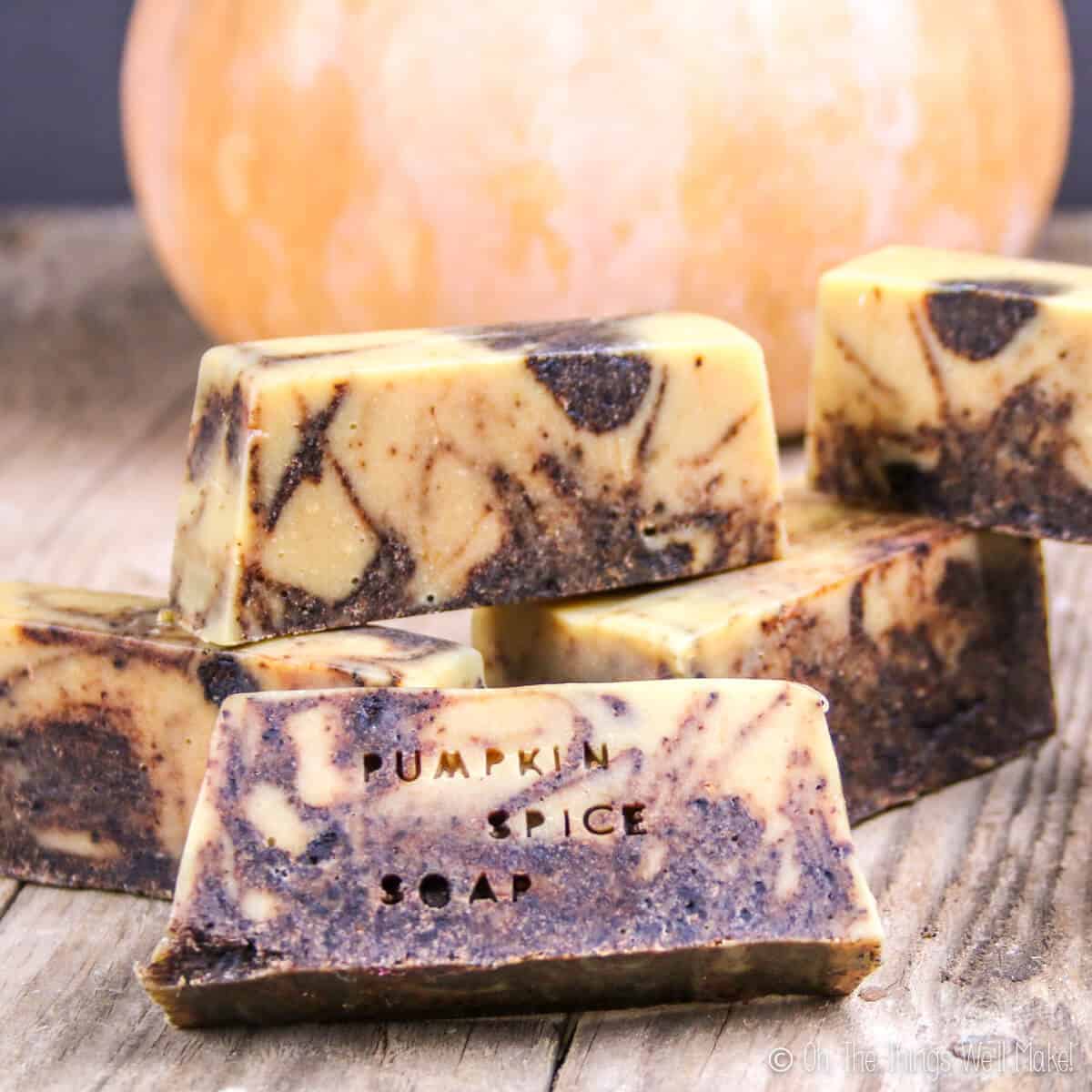
With autumn, comes cooler nights and shorter days. Halloween and Thanksgiving bring all sorts of fun pumpkin and apple spice recipes.
In celebration of this pumpkin spice time of year, I’ve decided to make a pumpkin spice soap.
What I love about this soap is that the scent lasts quite a bit longer than most naturally scented soaps. Perhaps it’s because it uses a combination of both essential oils and the actual spices. Or, maybe it’s just because the fragrance of these spices is more persistent.
Either way, I’m really happy with the final outcome.
A beginner recipe
If you have never made soap before, don’t worry. This soap is very simple to make. I purposely based this soap recipe on my easy, beginner soap recipe.
Because this recipe uses milk and adds a swirling technique, it is a bit more complicated than the other recipe. If that worries you, begin with the other recipe. If you’re adventurous, though, give this one a try! By following the directions carefully, even as a beginner, you shouldn’t have any problems.
My beginner soap is a tried and true recipe that only uses simple, easy-to-find oils. It also has a relatively long working time. The longer working time is perfect for beginners because it gives plenty of time to add in fragrance oils and spices. You should also have time to spare to swirl them together as I did.
To show how simple it is to adapt a soap recipe, I kept the main recipe exactly as it was. So, this recipe uses the same basic oils in the same amounts as the original recipe. For that reason, it also uses the same amount of lye and a similar amount of water. (This time, though, I switched out half of the water for goat milk. I also reduced it slightly because of the water in the pumpkin puree.)
Introducing new soap techniques
The beginner soap is great, but it’s also rather basic. I often get questions from readers who love that recipe, but who want to incorporate other ingredients. Today we will cover some of the ways to customize a recipe without changing the main recipe.
Adding goat’s milk
Rather than only use water, I decided to add some goat milk to this recipe. Goat’s milk is a very popular ingredient for soap because it is gentle and nourishing to the skin.
Making soap with goat’s milk isn’t just as simple as switching out the water for milk, though. Milk is a great ingredient because it has nourishing fats. Milk also has sugar in it, though, and the chemical reaction of those sugars with the lye can cause it to burn. That can leave your soap with an unpleasant scent and/or brown color.
To prevent that from happening, the milk should be added at a very cold temperature. This can be done by mixing it over an ice bath or even freezing the milk first.
Swirling technique
I also made this soap different from the basic recipe by using a swirl technique to give a fun, marbled appearance to the soap.
This soap is completely natural, but still has a fun look to it. The main soap mixture has the goat milk and a homemade pumpkin puree. (While it’s simple to make, you can also just use canned pumpkin instead.) To make the swirl, we’ll separate out some of the soap mixture and add our ground, dried spices into only one of the parts. The spices add a dark color to the soap, along with a beautiful aroma, and also add a very mild exfoliation.
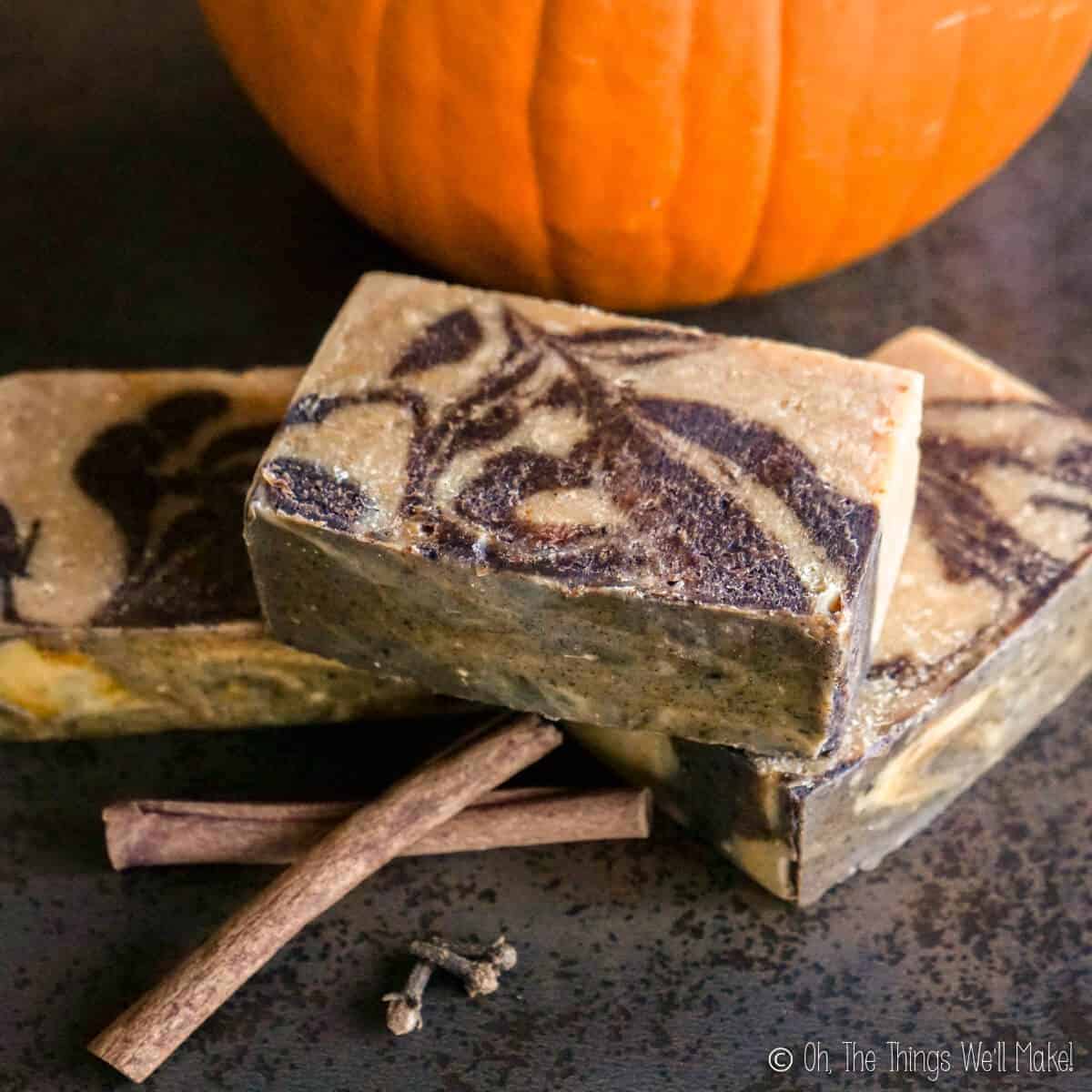
By swirling the spiced soap into the unspiced pumpkin soap, you end up with a pretty marbled looking soap. Some people make elaborate swirl designs with their soaps, incorporating a lot of bright colors. For today, though, we’ll start simple.
No matter what happens with your swirling, this soap should come out looking great. (I’m always a bit nervous about how it will turn out, but I’m also always pleasantly surprised by the outcome.)
Ingredients
Like the easy, beginner soap, the main base of this soap is made with olive oil, coconut oil, lye, and water.
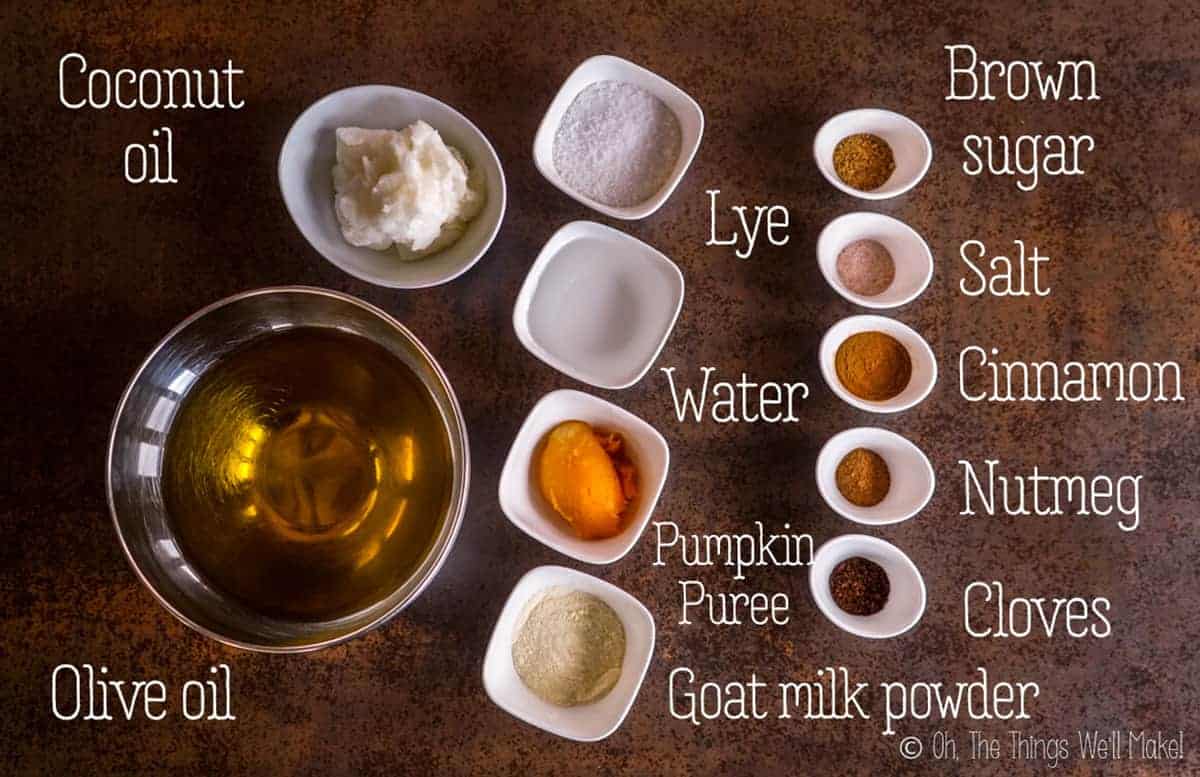
To give this soap more of an autumn touch, I added some pumpkin puree. While you could use canned pumpkin, it’s very simple to make a homemade pumpkin puree that is perfect for all sorts of recipes this time of year!
For creaminess, and to help nourish the skin, I also added goat’s milk. Pumpkin and goat’s milk both add a little color to the soap, and they also add some hydration and richness.
To add some more color and a beautiful scent, I added some pumpkin spices. While I could have stuck with just using essential oils, I chose to also add the ground, dried spices themselves to part of the recipe. That allowed me to show you how to make a simple swirling pattern for a homemade soap.
Procedure
This soap may look complicated, but it’s really quite simple. First, mix the lye solution with frozen goat’s milk.
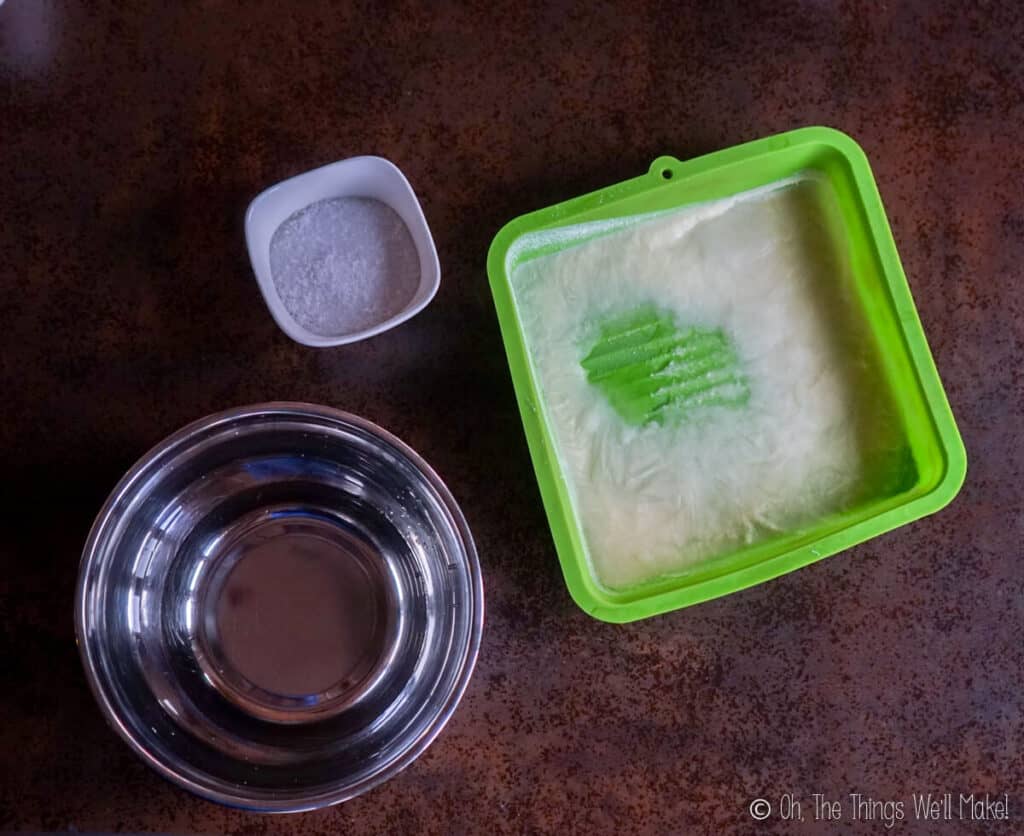
Lye, water, and frozen goat milk 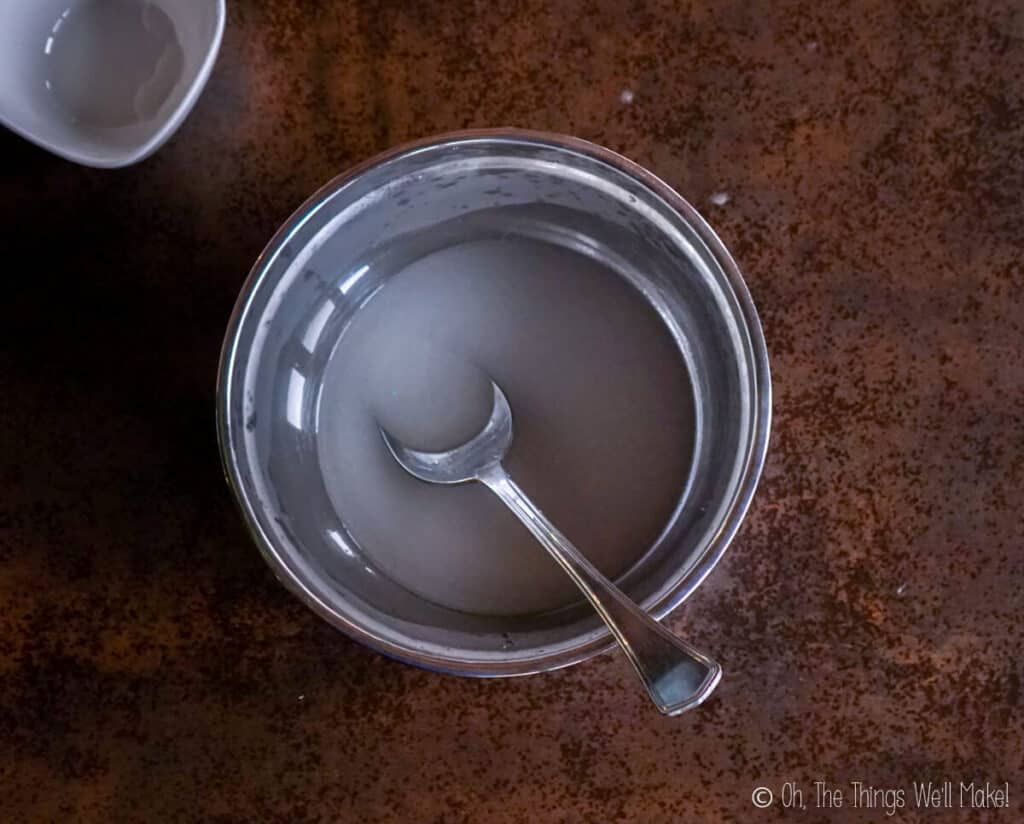
Lye solution (water with lye) 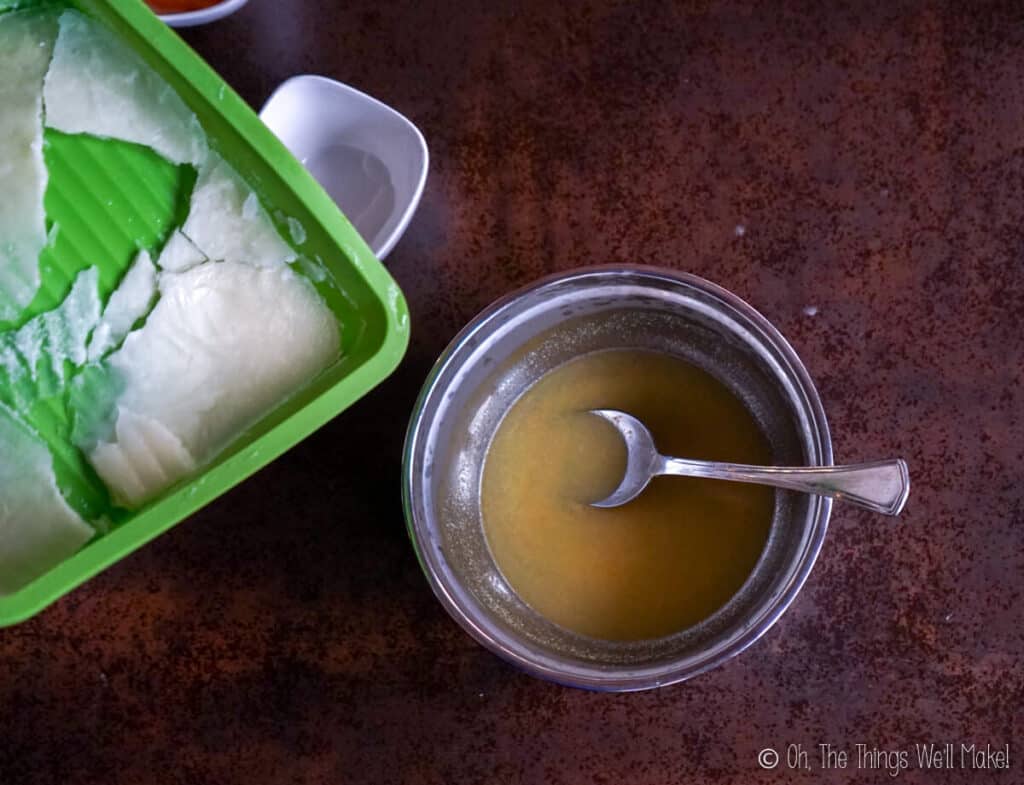
Add the frozen milk 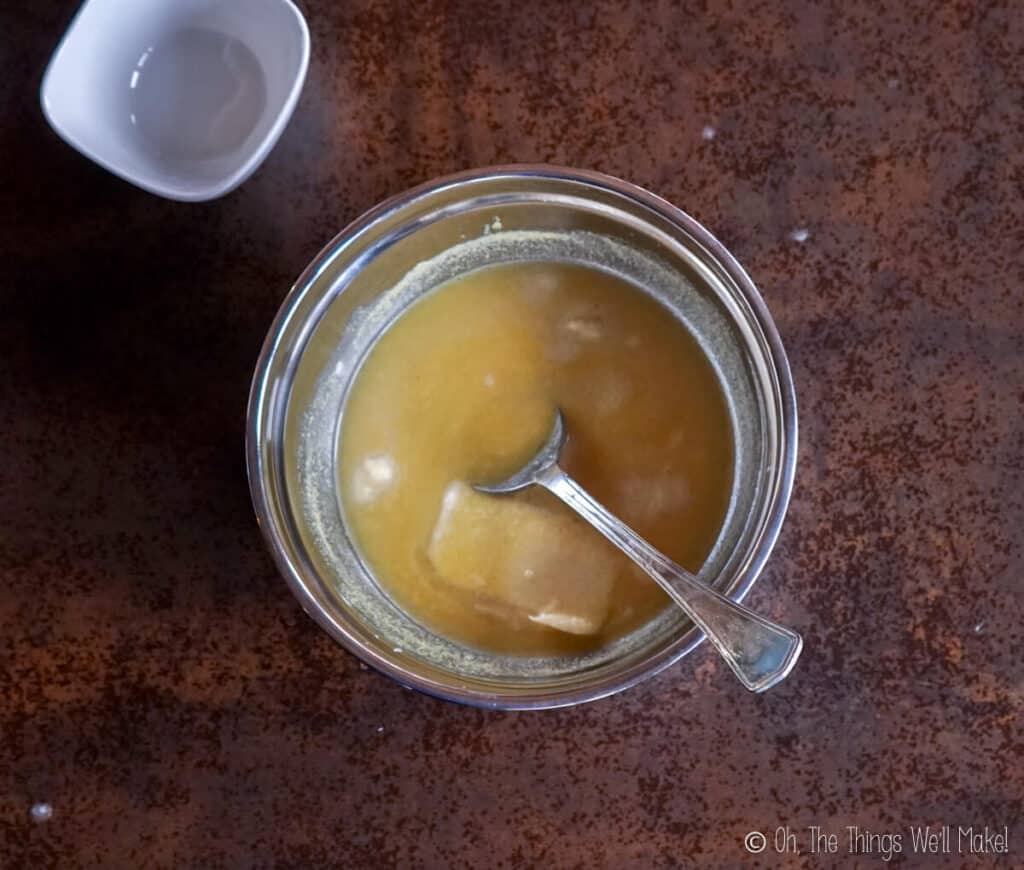
Then blend that mixed solution into the oils.
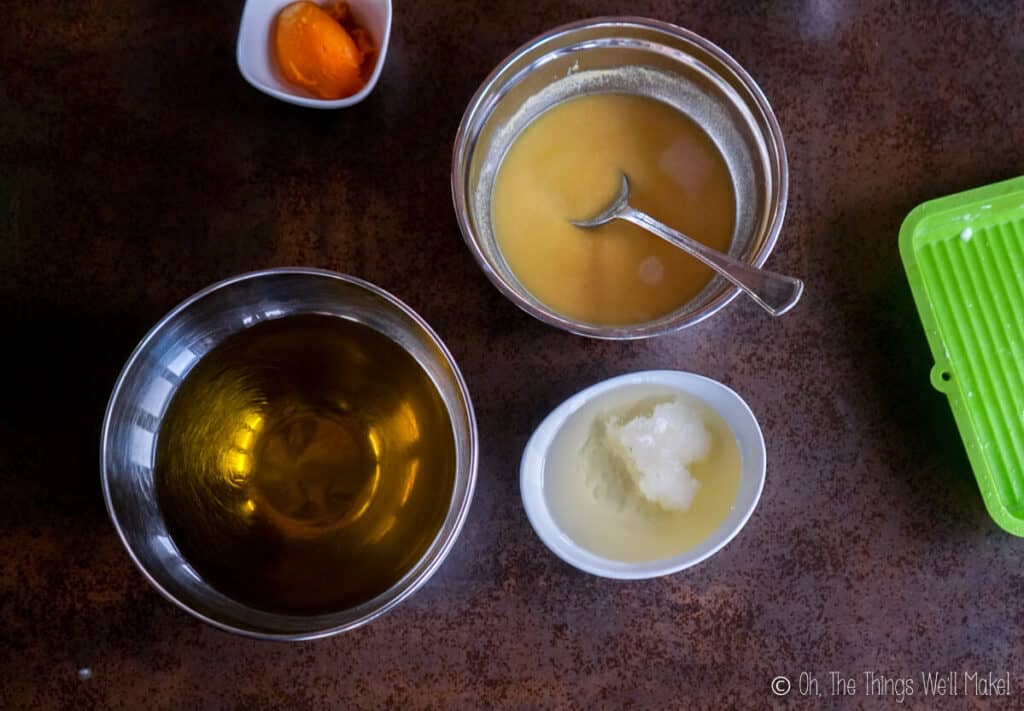

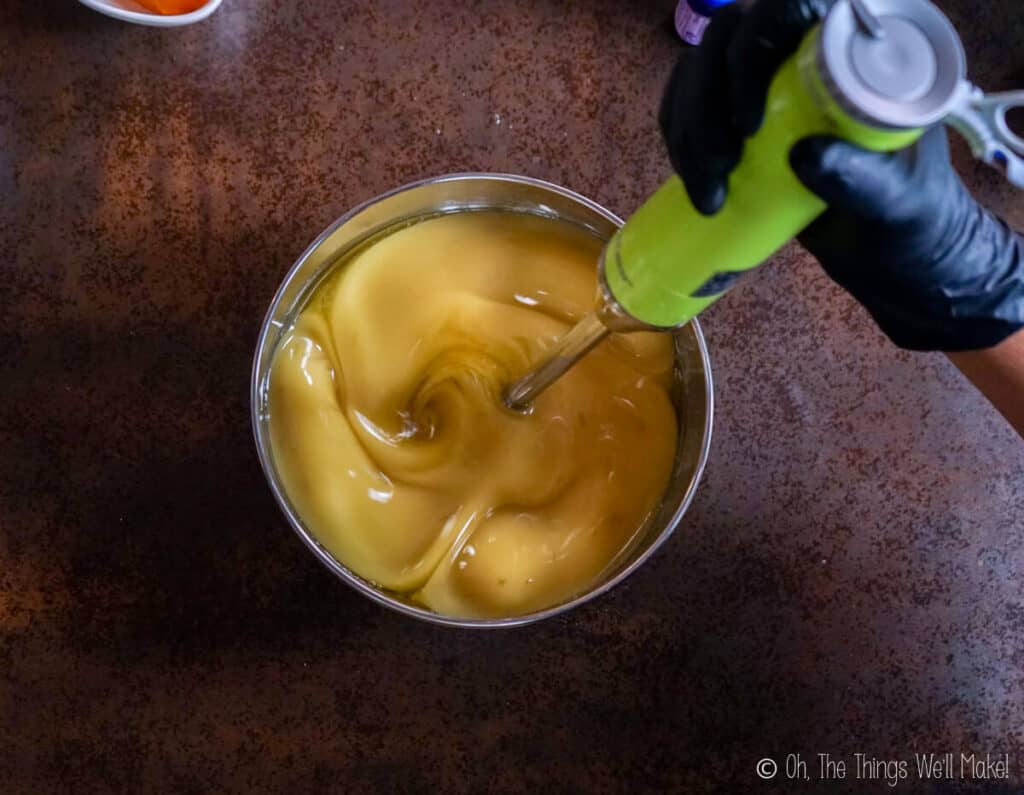
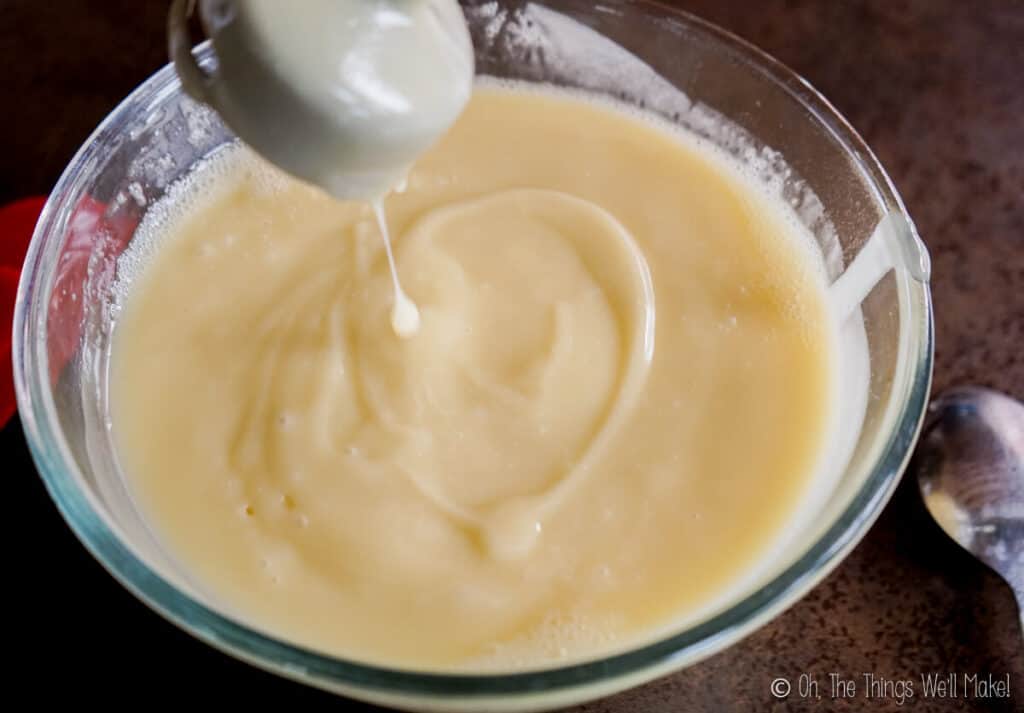
Soap at “trace”
Once we reach “trace” (when the soap is fully emulsified and looks like a thin mayonnaise), we will add our pumpkin and fragrance oils.
Then, we’ll separate around ⅓ of the mixture into a separate bowl.
At this point, we’ll add the ground spices into the soap mixture that we just separated out.
Once we have our two soap mixtures ready, we can begin to fill our soap mold. (I’m using a silicone loaf pan.) Pour half of the unspiced mixture into the mold, followed by half of the spiced, the rest of the unspiced, and finishing with a layer of spiced soap mixture.
To swirl the soaps, place a stainless steel spoon (or another utensil) into the soap.
Allow the soap to set untouched for around 24 hours. Once it’s hard enough to unmold it, gently remove it from the mold and cut it into bars.
That’s all there is to it. You should let the bars of soap cure for around 3-4 weeks before using them. (During that time, they will harden and improve.)
Customizing the recipe
Even this recipe can be slightly customized to suit your taste.
Adding color
I originally left this soap its natural golden color. This year, though, I wanted to try something new and incorporate a natural orange color by adding some ground achiote to the soap. Unfortunately, when I was ready to make it, I realized I didn’t have any on hand. So, I used paprika instead. Paprika is another way to naturally color the soap, but it doesn’t turn as orange as it would with achiote powder.
Other changes
Don’t want to use goat milk? Just switch it for another 100ml of water.
If you don’t want to do the swirl technique, you can either add the spices to all of the soap (which will result in a brown soap) or don’t use ground spices at all (for a golden colored soap).
Safety Tips
As with all soap recipes, be very careful when working with the lye solution.
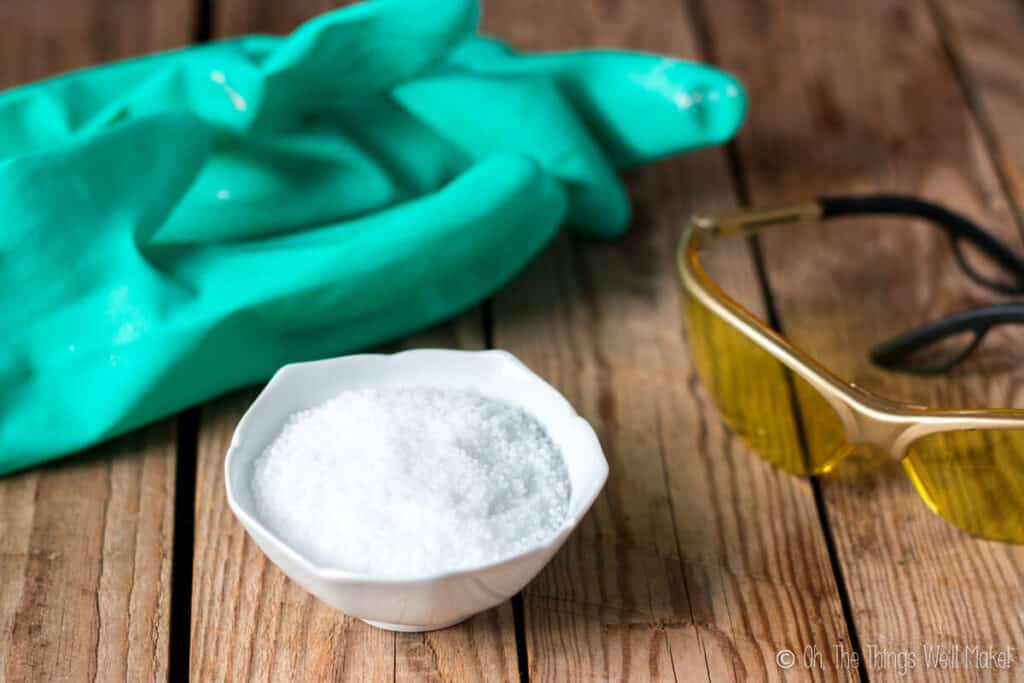
- When making soap, use protective eyewear and gloves. To make the lye solution, pour the lye into the water rather than the other way around!
- Mix the ingredients together outside or in a well-ventilated area. For more safety tips, read my beginner soap recipe post.
Video
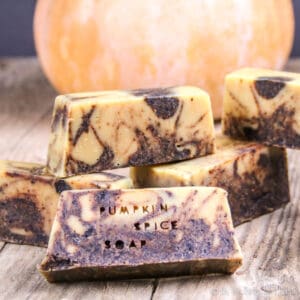
Easy Pumpkin Spice Soap
Materials
- 100 g coconut oil
- 500 g olive oil
- 80 g lye 2.8 oz.
- 100 ml goat milk either fresh or reconstituted from powdered
- 100 ml water
- 45 g pumpkin 1.6 oz., I made my own puree
- 1 teaspoon coconut sugar or any brown sugar
- 1 teaspoon salt
- 1 Tablespoon cinnamon
- 1 teaspoon nutmeg
- 1 teaspoon ground cloves
- clove essential oil & cinnamon and ginger essential oils
Instructions
Prepare the goat milk
- Place the goat milk in the freezer while weighing/measuring out the other ingredients. (You'll want to have the spices ready to go so that you aren't rushed later on.)
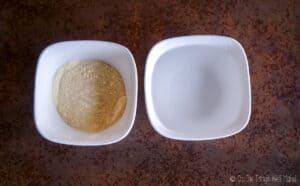
Prepare the lye solution
- Carefully pour the lye into the water in a stainless steel or plastic bowl. (For more safety tips, read my easy beginner soap recipe post.) Mix in a well-ventilated area. The mixture will heat up and become cloudy. Try to dissolve all (or most) of the lye before adding in the goat milk.
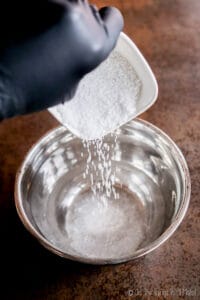
- After a few minutes, begin adding the cold goat milk. I like to add it when it's frozen to avoid scorching the milk. If your milk isn't frozen, you can also mix them together over a pan of ice and water. Your solution will probably yellow. That is a normal reaction of goat milk and lye.
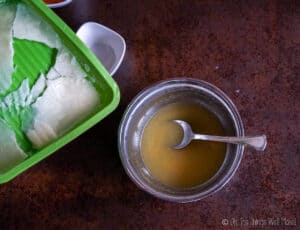
- Add the sugar and salt to the lye solution. Once the solution is thoroughly mixed, allow it to rest while you get together the other ingredients.
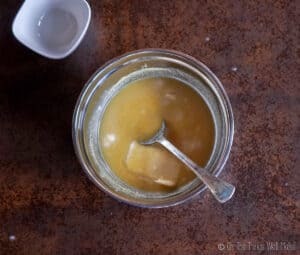
Combine the lye solution and the oils
- Melt the coconut oil if it is in a solid state. Then, combine the oils in a large bowl.
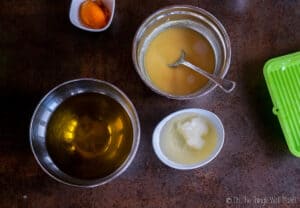
- Add the lye solution to the oil mixture, and gently mix them together.
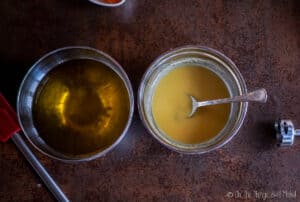
- Once the lye solution is incorporated into the oils, carefully mix them together with an immersion blender. The mixture will become creamy looking and, after a few minutes, will thicken into a thin, mayonnaise-like texture. (If your ingredients are cold, it will take a bit longer.) At this point, it's called "trace." We can now add in other ingredients.
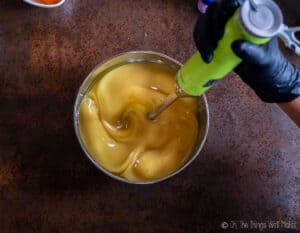
Add in other ingredients
- Add the pumpkin puree to the soap mixture. If you want to add an orange pumpkin color, now is the time to add in some achiote powder (start by mixing in a small amount and add more as desired) or a soap colorant.
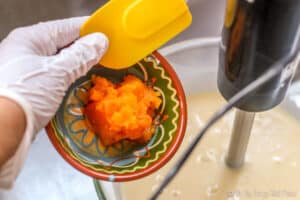
- Add the essential oils or cosmetic grade fragrance oils, if you prefer. Certain essential oils, like clove oil, may cause your soap to thicken more quickly, so be prepared, just in case. I didn't find it to be an issue, but it may depend on the oil. You can experiment here, and use your nose to help guide you. I used mostly clove oil, followed by some cinnamon and ginger oil. 😉
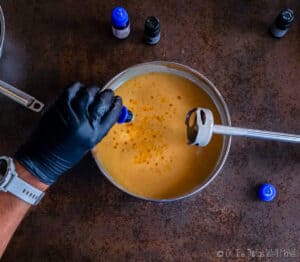
- Separate out about ⅓ of the soap mixture into a separate bowl. Add the ground dried spices to the ⅓ that you separated out. Mix well to fully disperse them in the mixture.
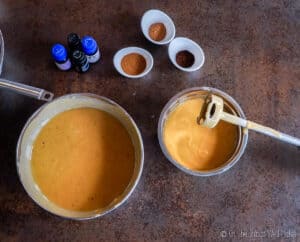
Pour into molds
- Pour about half of the un-spiced soap mixture into your mold. (I'm using a silicone loaf pan.)
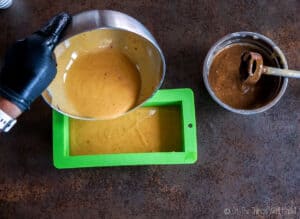
- Add a layer of the spiced soap using about ½ of the spiced soap mixture. If it appears to fall to the bottom in one area, carefully spoon it over the top to completely cover the unspiced layer.
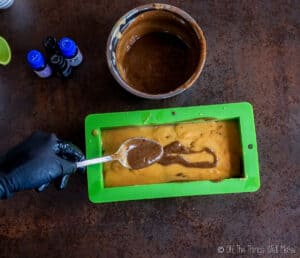
- Cover that layer with another layer using the rest of the un-spiced soap mixture. Then, cover that, as before, with the rest of the spiced soap.
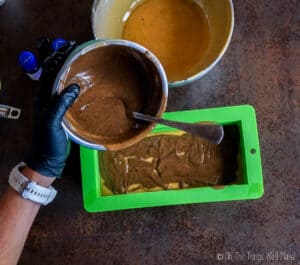
Swirl the soaps
- Using a spoon or some other utensil, poke into the soaps, reaching for the bottom layer and pulling the soap out over top, trying to gently swirl the soaps in certain places. You can also zigzag your way through the soap in places, to have the soaps gently swirl together, without fully mixing them into each other.
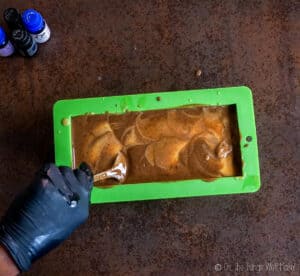
- Once you've gently swirled all over the soap, allow the soap to rest for at least 24 hours.

Unmold and cut the soap
- After 24 hours, you can begin to check the soap to see if it's hard enough to be gently unmolded. If it is too soft, wait another day and check on it again. Once hard enough, gently unmold it. (Don't wait too many days or it may be difficult to cut into bars.)
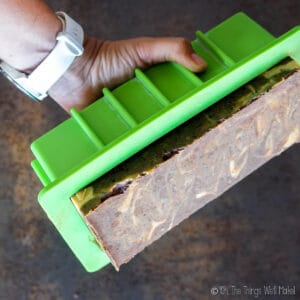
- Once you've removed the block of soap from the mold, cut it into bars. You can make your soaps as thin or as thick as you like.

Curing the soap
- Place the soap on parchment paper or cardboard with air space between the bars. Allow them to cure for several weeks, ideally at least 3-4 weeks. During this time, the soap will harden and the crystalline structure will continue to form. To help the soaps dry thoroughly on each side, flip the bars of soap every couple of days at first. Once cured, it's ready to use like any other soap. Enjoy!
 Español
Español
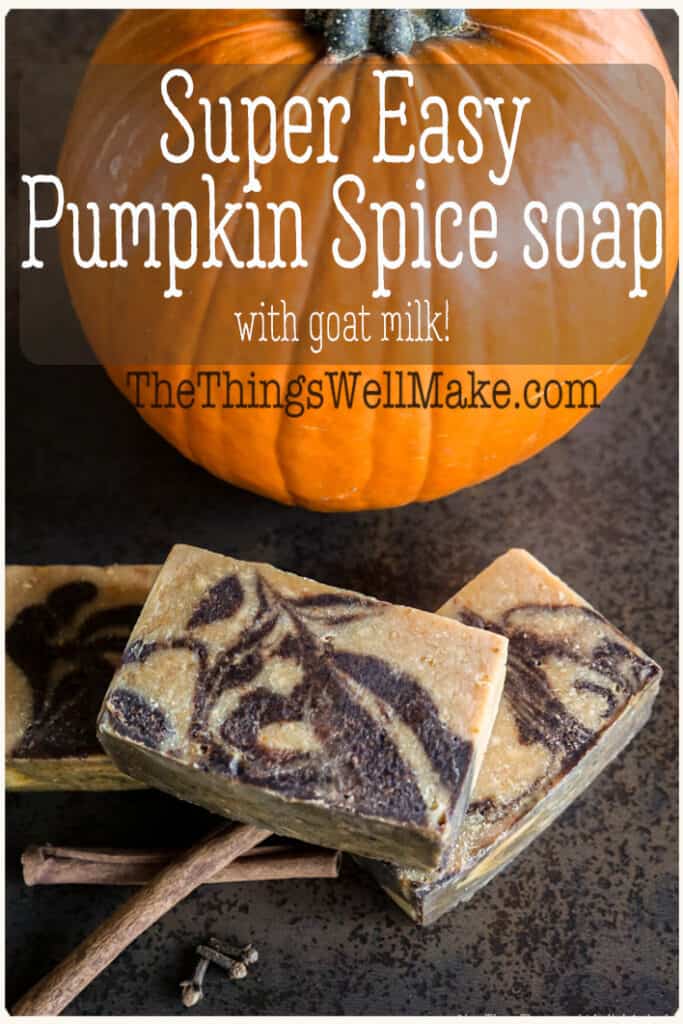
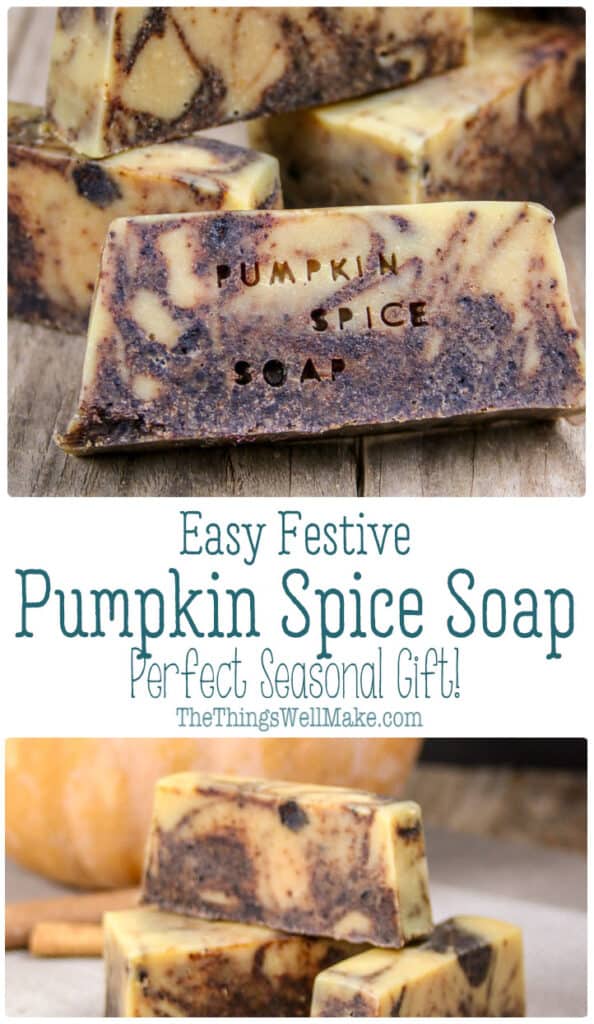
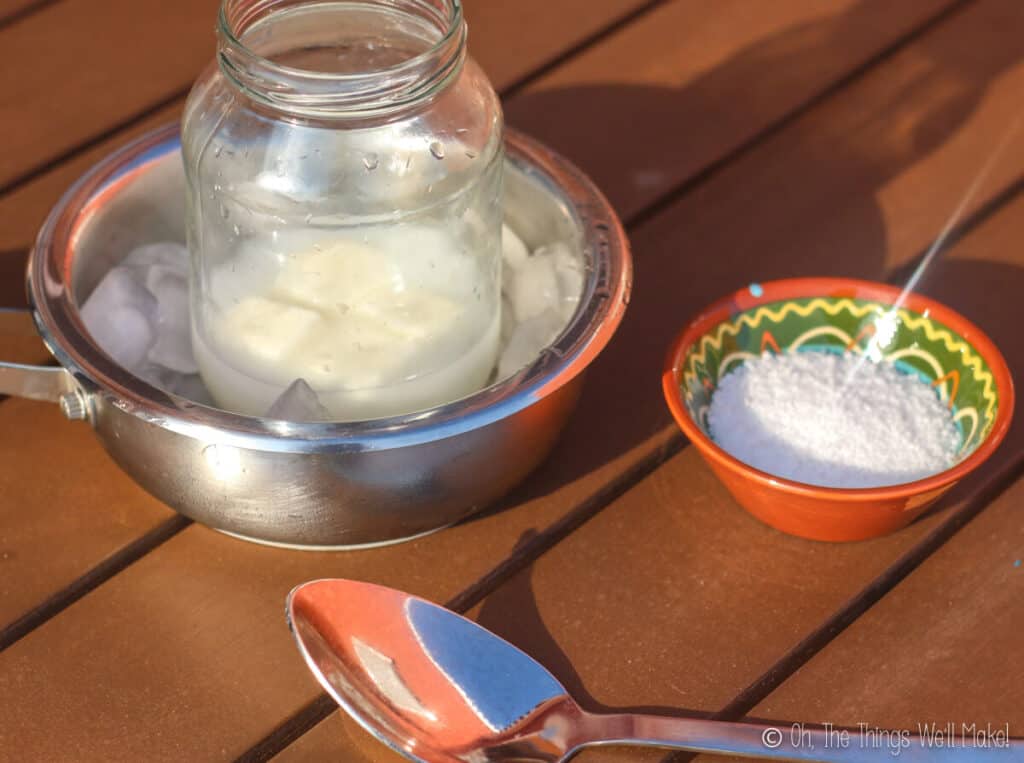
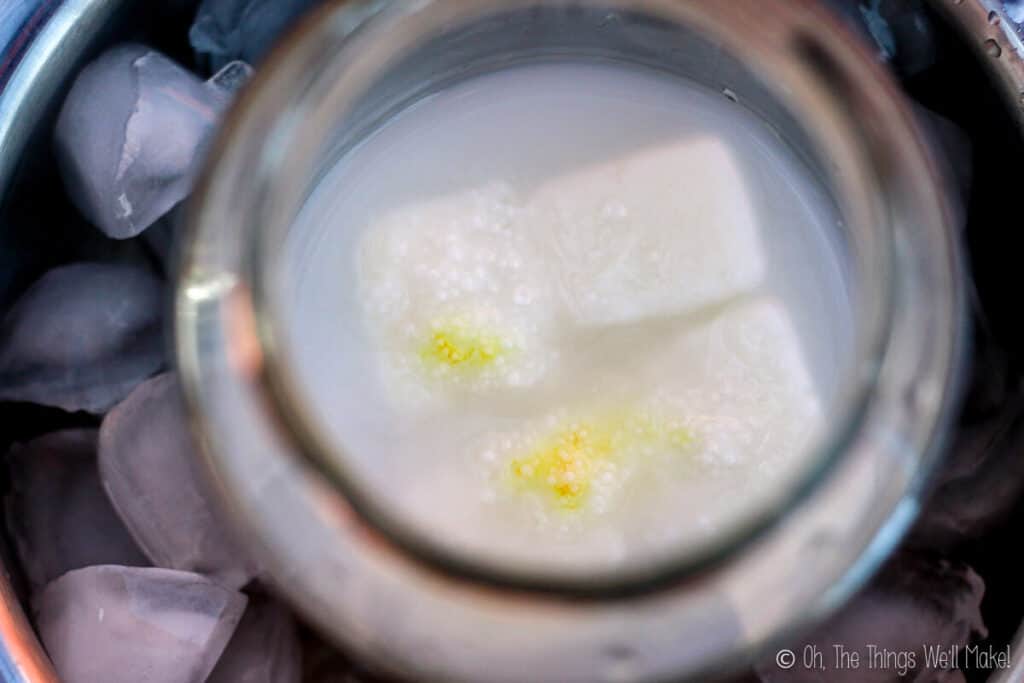
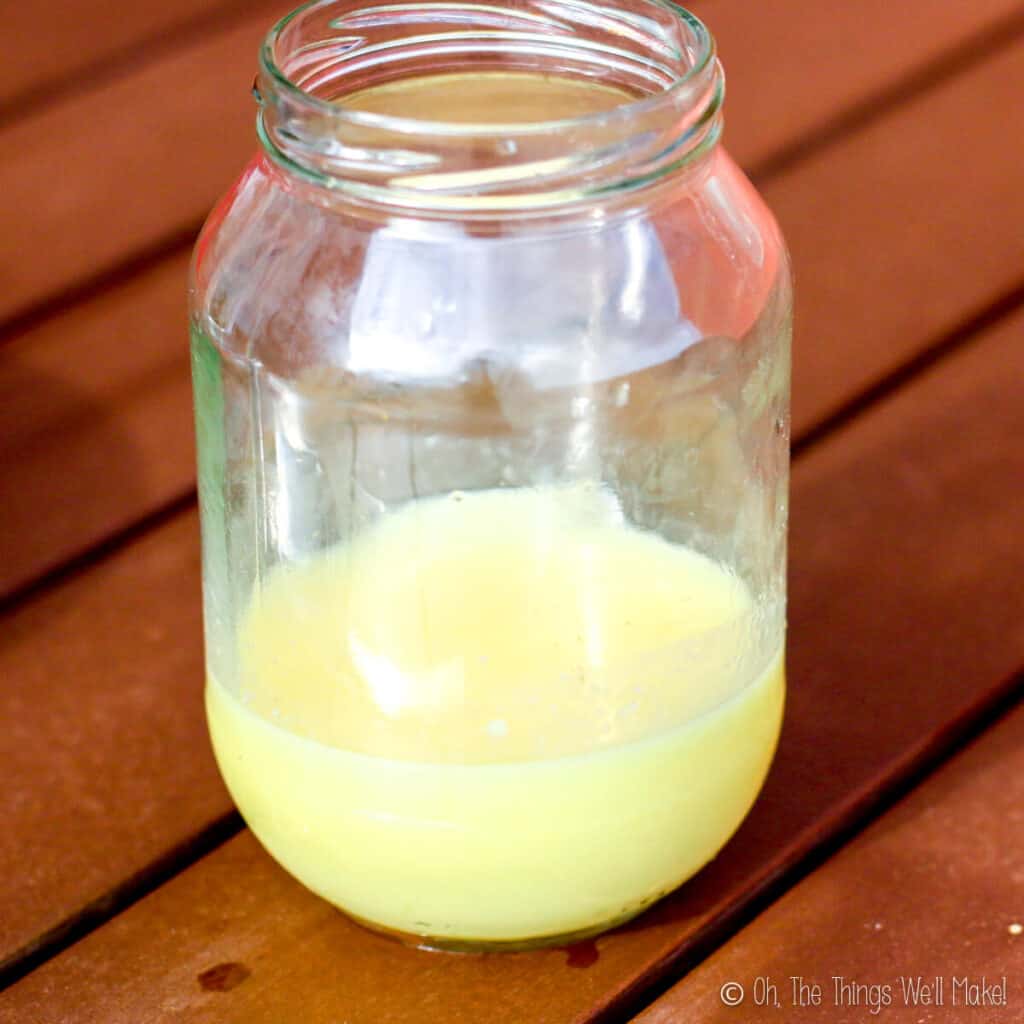
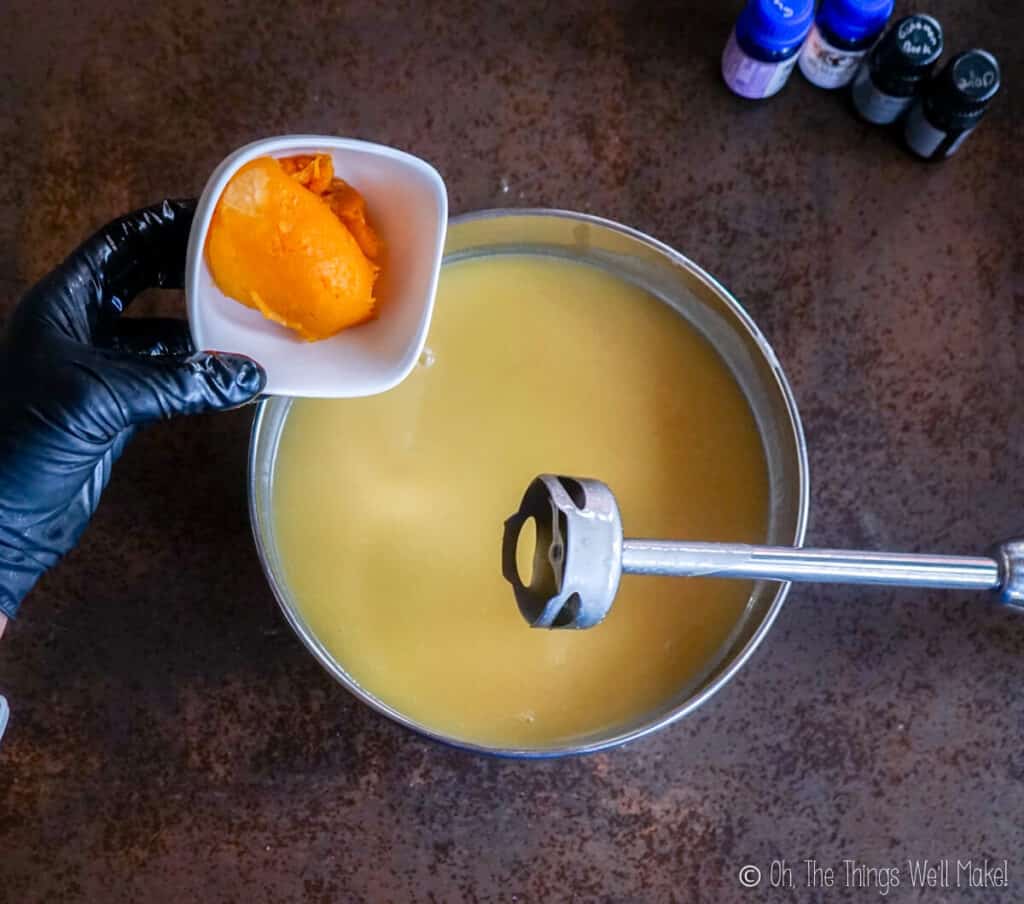
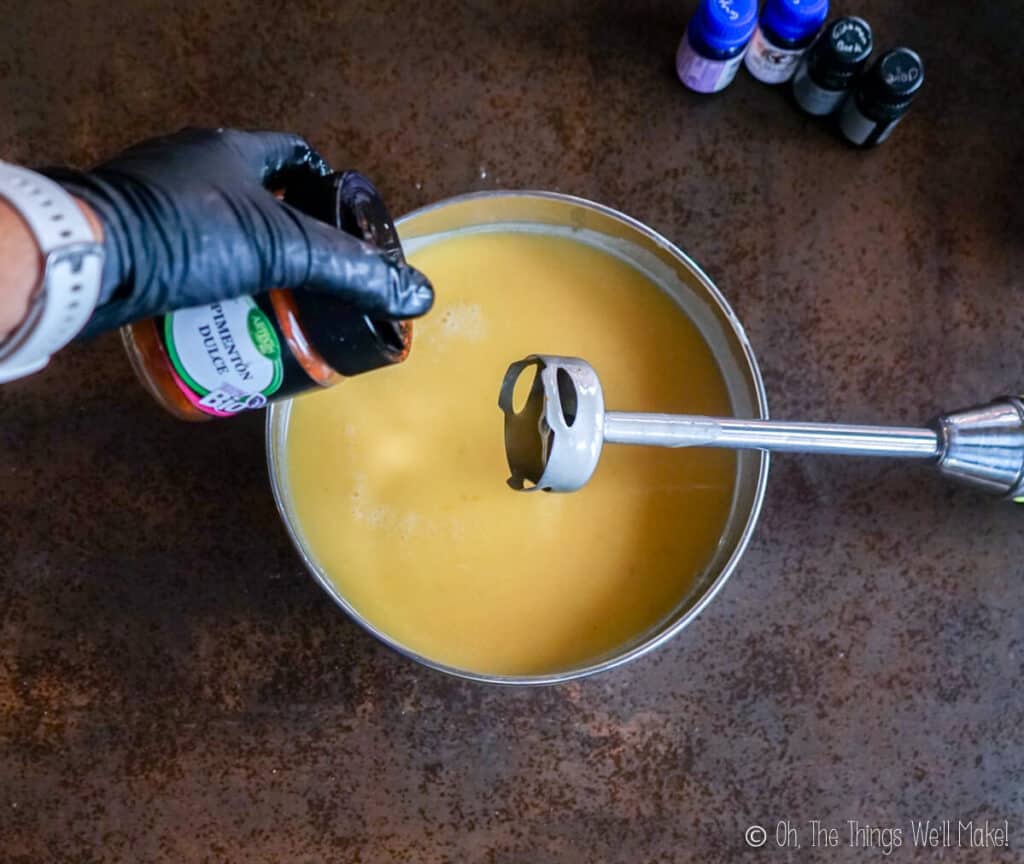
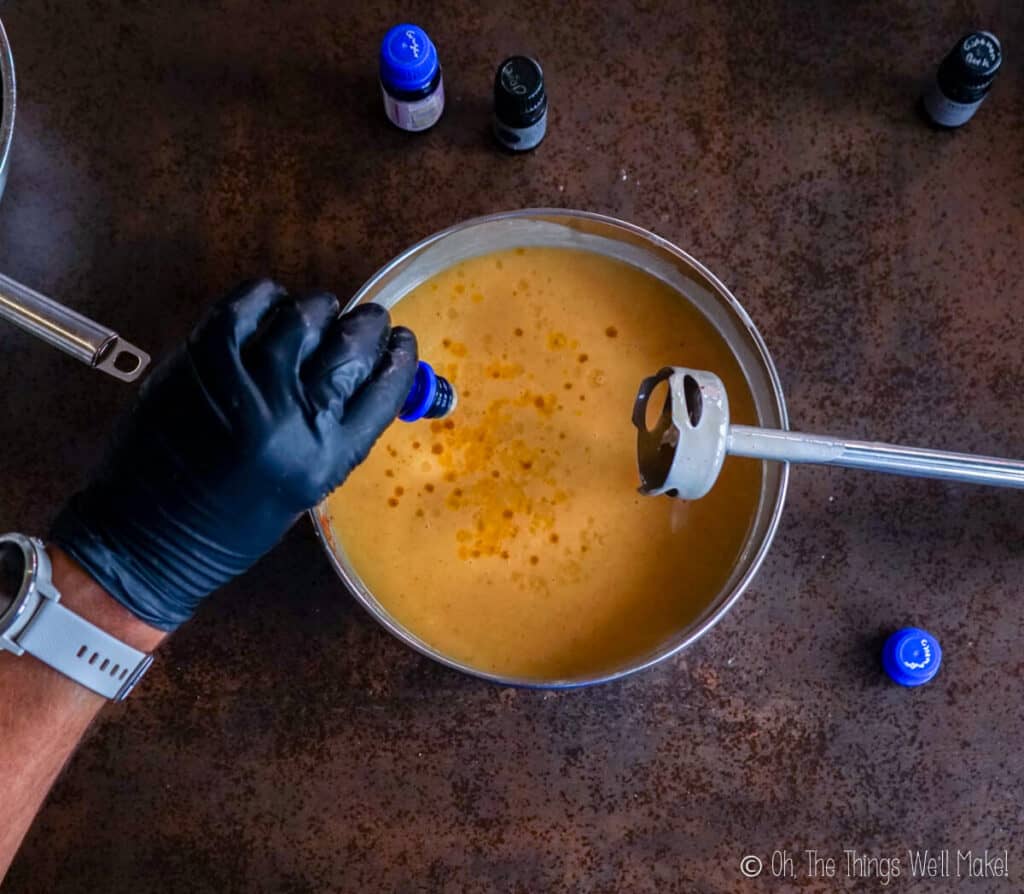
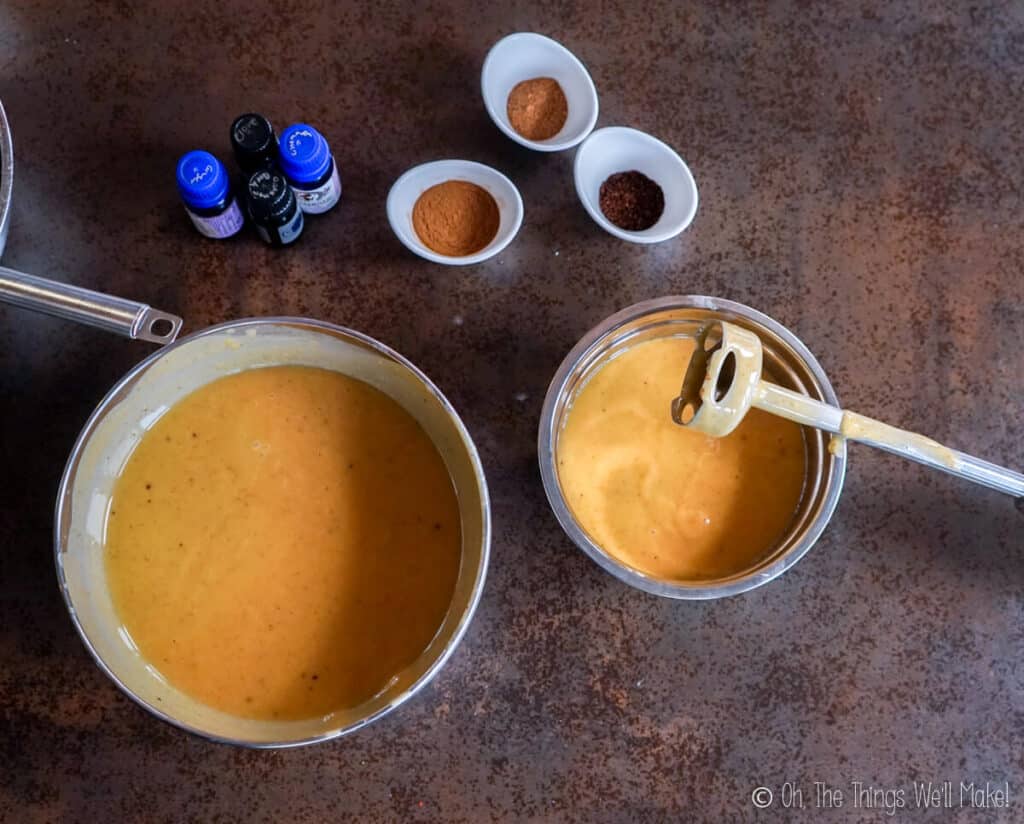
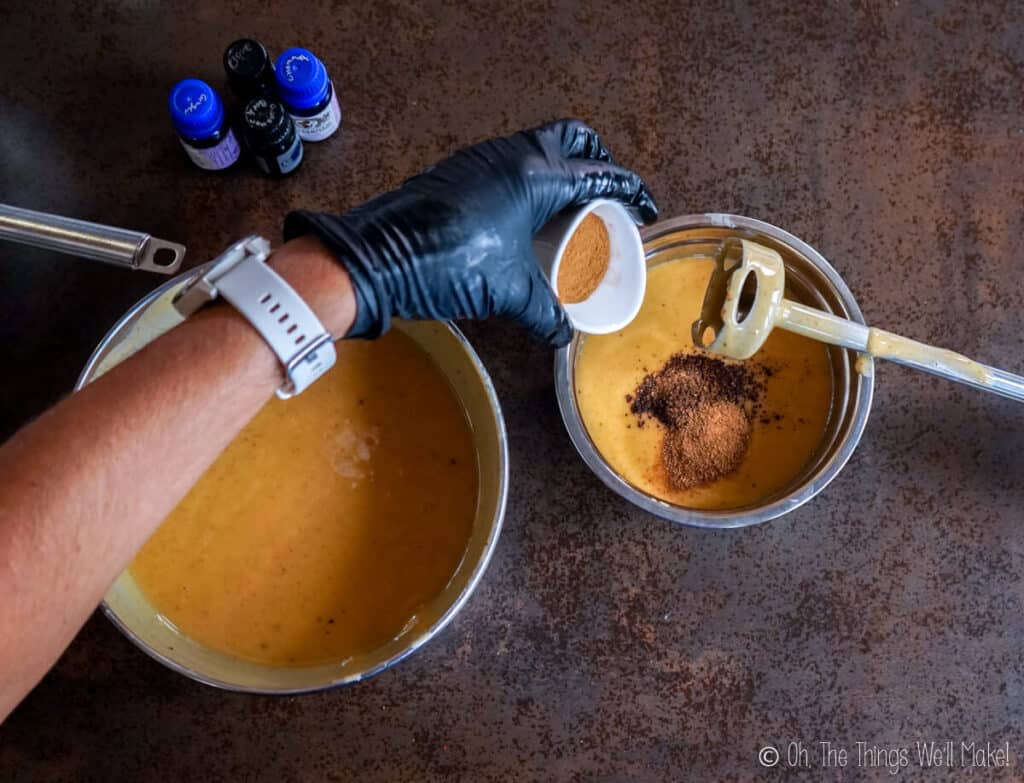
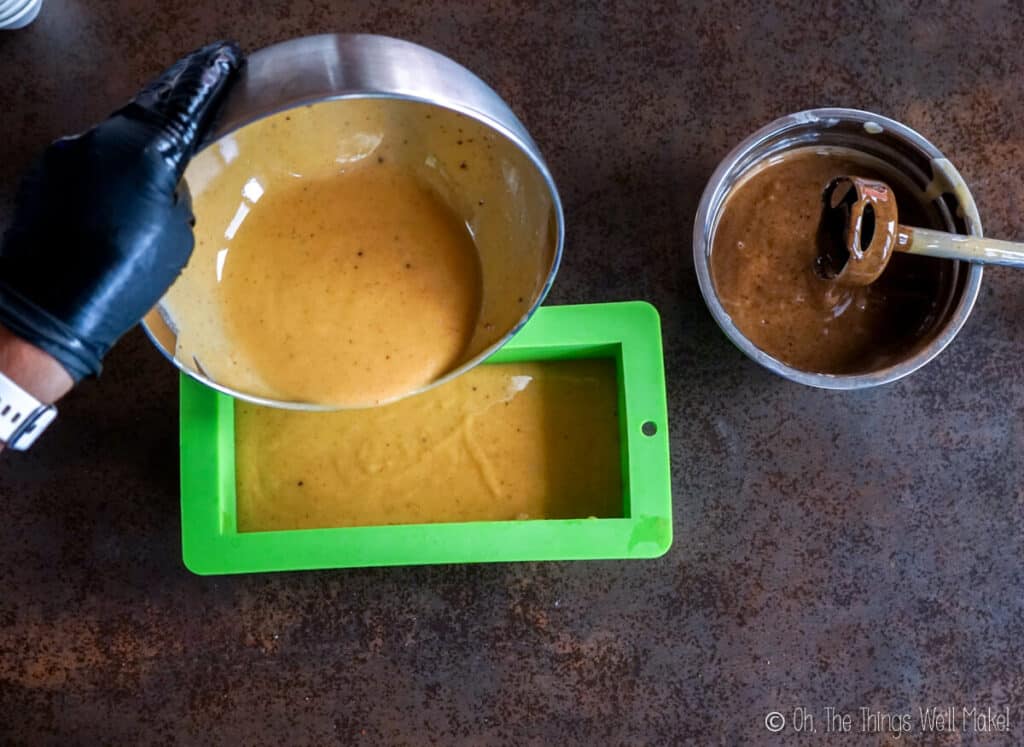
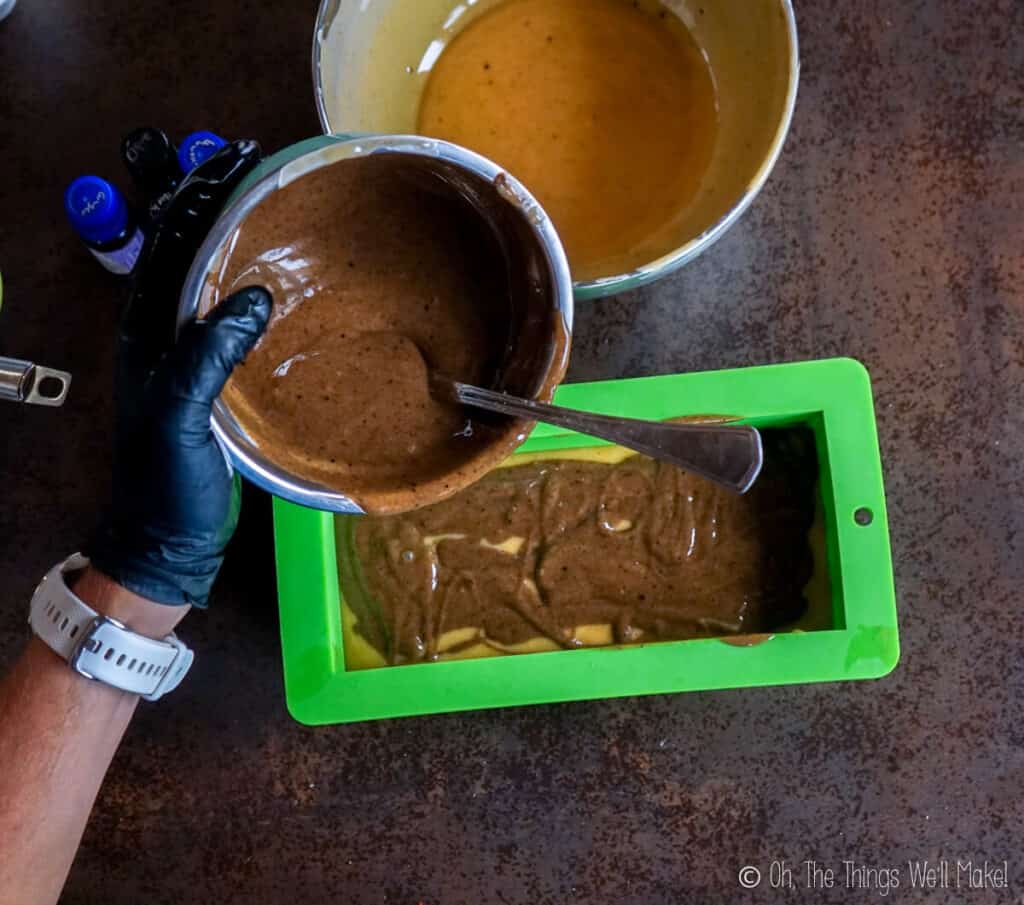
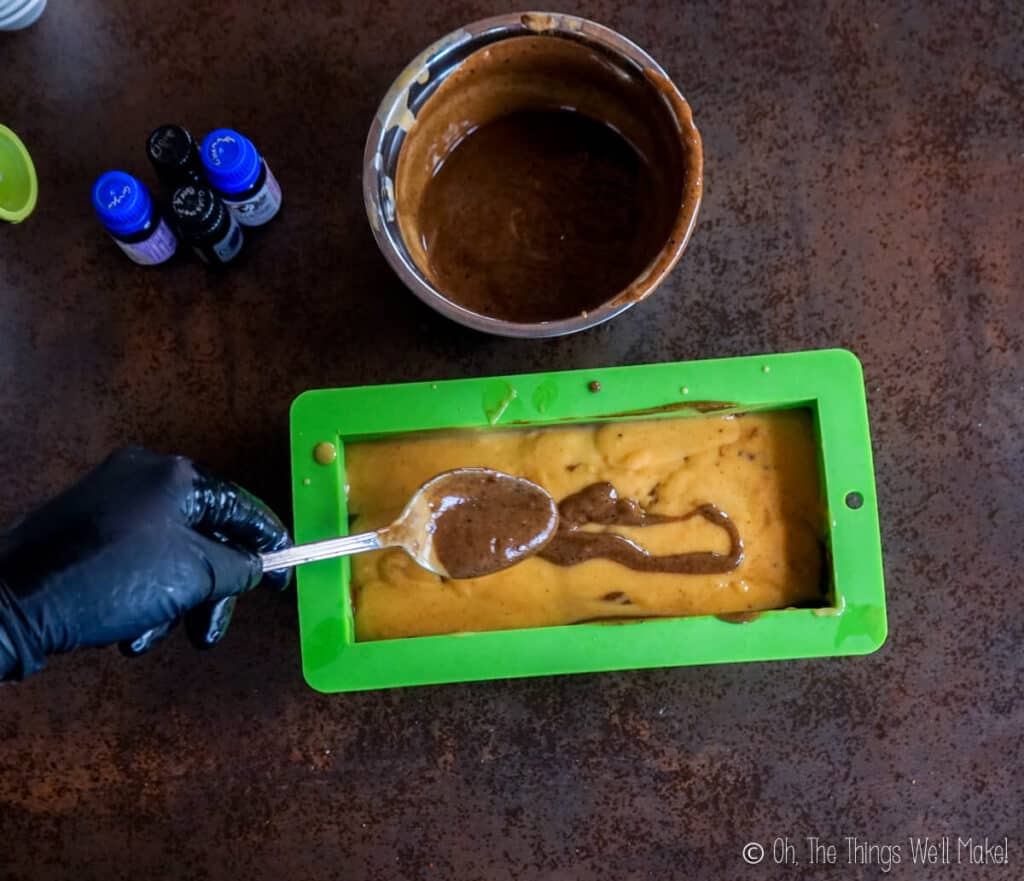
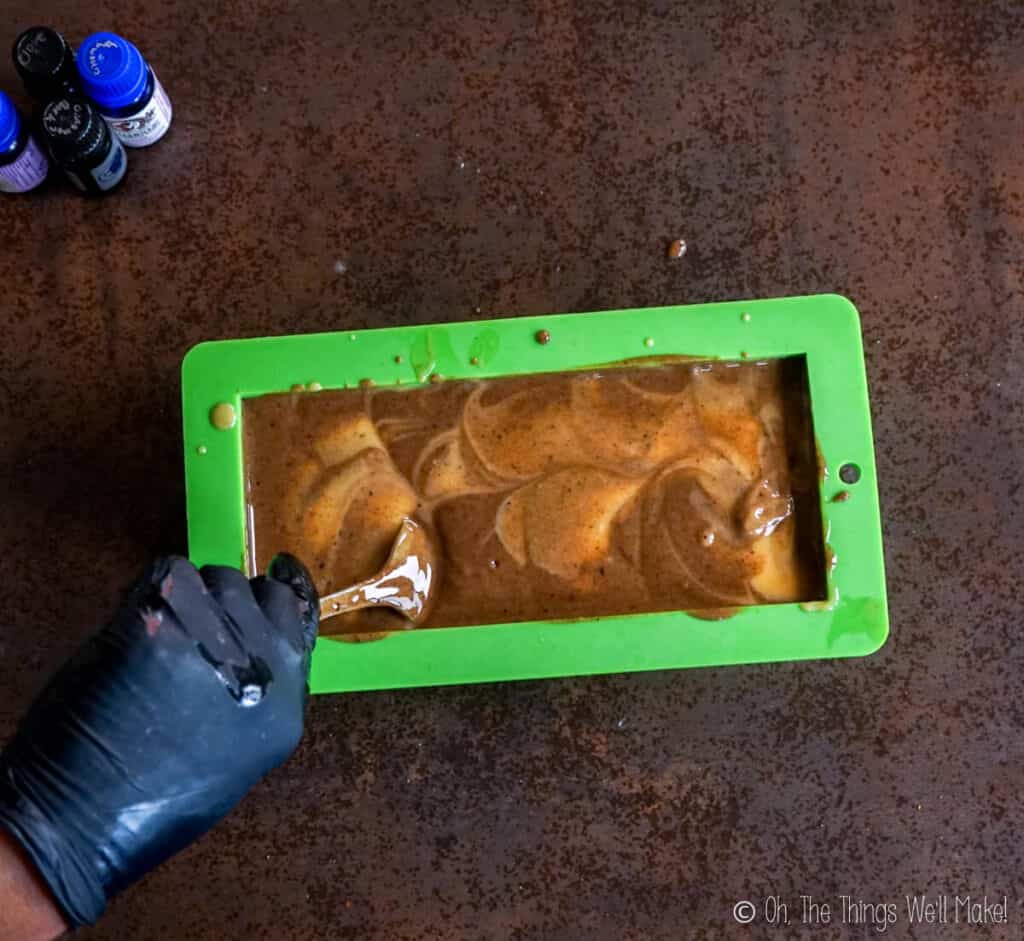
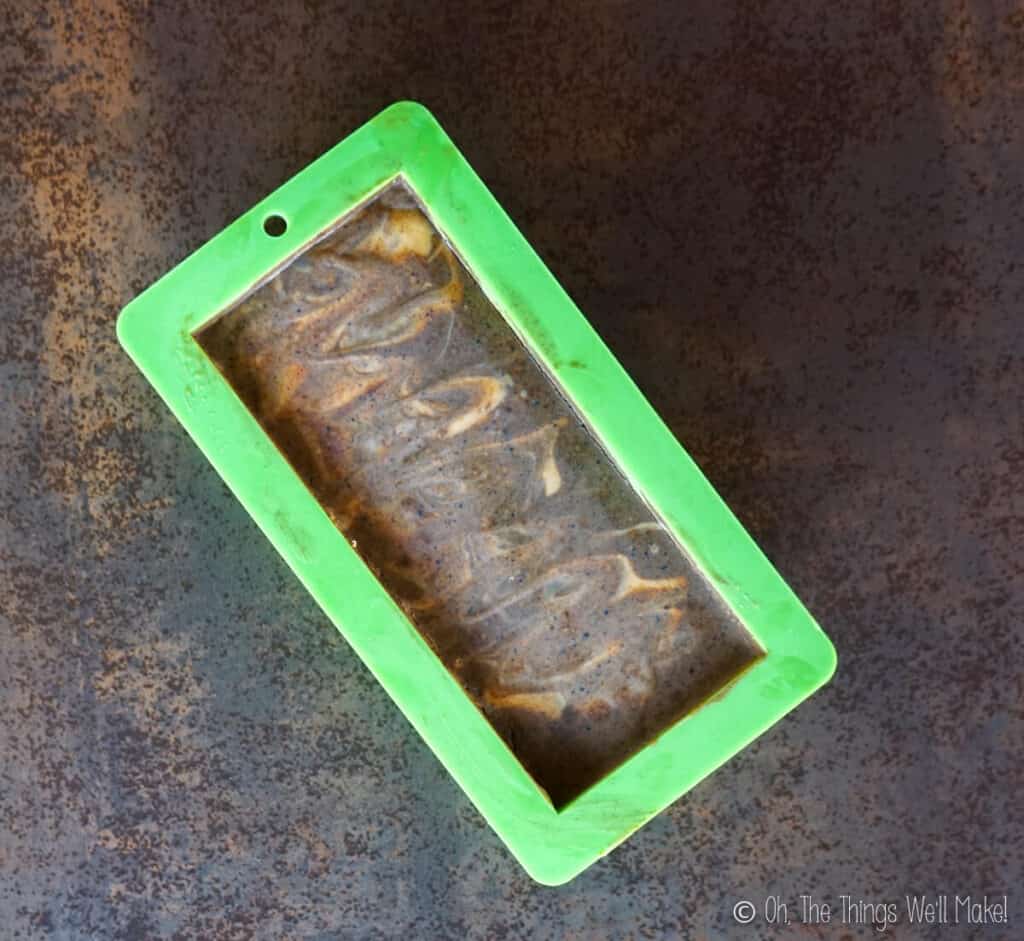
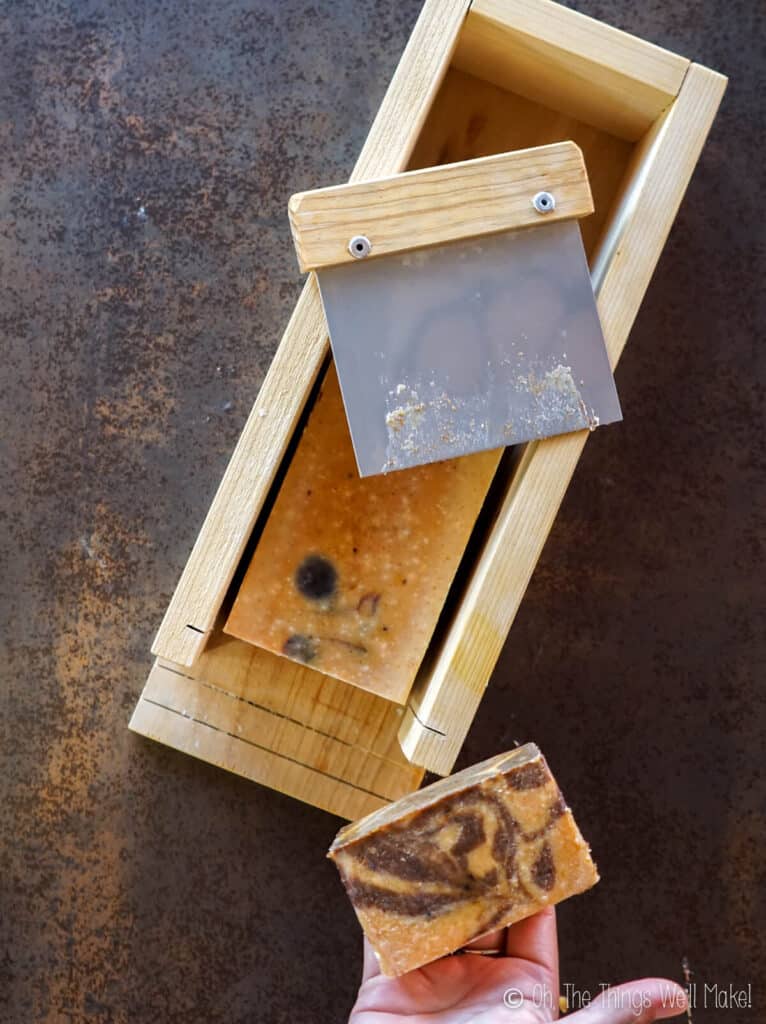
 Making an Easy, Basic Beginner Soap, and Then Making it Fun!!
Making an Easy, Basic Beginner Soap, and Then Making it Fun!!
Damanda
How many bars does this recipe yield? I would like to make approximately 25. Thanks so much for sharing your recipe! I am really excited about trying it!
Tracy Ariza
Hello!
It really depends on the molds you use and how big you want each bar to be.
I usually use a standard silicone loaf pan when making this recipe. My pan is around 9 inches (23 cm) long, so if I were to make each bar with a width of 3/4 of an inch (just under 2cm), I’d get around 12 bars of soap. If I wanted thicker bars, I’d get less. Keep in mind that they may slightly shrink down as they dry and cure.
I’d aim for somewhere between 2-3 batches for 25 bars.
Camellia
This looks like a great recipe. Where did you get your stamp to label your soap?
Camellia-
Tracy Ariza
Hi Camelia,
This is actually a stamp for fondant normally, but it works well in the first days after unmolding the soap. The letters are a bit small, though, so you have to be careful while stamping or you take out too much soap when you remove it.
Mine looks like this fondant stamp. It’s not perfect, but it works.
I like the look of this stamp better (it’s a bit of a pain to slide the letters into the other one), but it’s also more expensive, so I’m not sure if it’s worth the difference in price. It also may not be long enough for some projects.
Annelie Hollstenius
What about using 200 ml goat milk instead of water? Would that work?
Tracy Ariza
Hi Annelie,
You could try it. I normally like to use some water with it so that I can mix the lye with the water and have the milk in its frozen state. I want to avoid burning the milk. If you use frozen milk or at least milk in a slushy state, you probably would be fine. At the worst, it may brown slightly.
Priyanka
Hi Tracy,
I am so happy I found your video and recipe. It is just what I was looking for.I will be making my first soap and I have been looking for an easy recipe also I am trying right now so I don’t wish to use expensive oils. Do you have any specific recipe where I can use reasonable oils ( canola, rice bran oils,palm oil etc). I don’t have butter with me, can’t get Shea butter etc as well.
Where I stay coconut oil and olive oil is very expensive so I was just thinking about few other options.Pls do share your recipe ( gm measurement) only. You may email me recipes if you feel like it. I’ll be very thankful to you dear Tracy.
[email protected]
Thank you
Priyanka
Tracy Ariza
Hi Priyanka,
Most vegetable oils don’t make a very good bar of soap. They will make softer bars of soap that may get brown spots quickly and that don’t cleanse very well. Coconut oil and olive oil are the exceptions, and either can make a decent soap even without the use of any other oils.
You can use other vegetable oils as part of a recipe, but in lesser amounts and in conjunctions with some other fat that will make a harder, more cleansing bar of soap.
Are you opposed to using animal fats? The only alternative I can think of, if you don’t want to use coconut or olive oil, is to use either lard or tallow. Those fats could be combined with other oils to make a decent bar of soap. Palm oil should work decently too, but I’ve never personally used it.
Tracy Ariza
I should elaborate that not only do different oils make different type soaps, but that each will need a different amount of lye. So, you can’t just switch out the fats in a recipe, you’d need to run the numbers in a lye calculator.
Ida
I’ve made this soap a couple of times but I find it seems to dissolve quite quickly. After one use in the water it had a lot of little pin holes through the whole bar. I’ve let it harden for 6 weeks before using it. What am I doing wrong?
Tracy Ariza
Hi Ida-
Hmmm, that’s interesting, and something I’ve never heard before. I had bars of that soap last for forever, and that never happened to me.
Do your bars feel hard before using them?
This soap does use a lot of olive oil, and olive oil based soaps really do benefit from a long curing time. Some people wait for a year before they use soaps like a pure Castile soap or an Aleppo soap.
So, I was going to suggest letting it cure longer- but I feel like there must be something wrong with the bar itself if you are getting actual holes in it! That shouldn’t happen even with freshly made soap!
Is there a way you can send me a picture by email to [email protected] so I can see it and maybe we can try to troubleshoot the problem better?
Kim
Sounds like air bubbles have gotten mixed into your soap – make sure when mixing you’re not incorporating air into the soap & when pouring into molds use rubbing alcohol & spray it over soap – hopefully this helps
Tracy Ariza
Thanks, Kim! 🙂
Inger Orr
This is so beautiful! I want to make it for Christmas gifts, but I don’t have a lot of time for curing before Christmas, so I wanted to use a ready made goat’s milk soap base. Is this possible, and, if so, how much soap base would I use with the remainder of the ingredients?
Tracy Ariza
Hi Inger,
I’m sure you’d be able to do it by using, by weight, the amount of soap that corresponds to the oils+lye+water+milk in the recipe. That said, if you were to make them this week, you’d still be able to give away a nice homemade gift.
The month waiting period is a guideline. The soap in a month has time to harden so that it won’t be so soft that it gets used up quickly. It also gives it time to continue some slower chemical reactions in the soap so that the soap improves.
All of that said, in a couple of weeks, the saponification process will have completed, and you’ll definitely have a useable and pretty soap. I’d just let everybody know that the soap is recently made and will improve with time. 😉
Sara
Hello, I am new to soap making and would like to try making this for holiday gifts, but I’m confused about the instruction to freeze the goat’s milk. Do you measure the amount needed, then freeze it solid? Then do you thaw it again before combining the goat’s milk and lye? I am using fresh, not powdered, goat’s milk. Thanks so much!
Tracy Ariza
Hi Sara,
I used fresh milk too!
Yes, you measure out the milk and then freeze it. You keep it frozen when you mix with the lye (so, no, don’t thaw it!) to keep the milk from burning. You’ll find that lye has a strong reaction even when mixed with water. It heats up a lot.
When mixing with something with sugar in it, like milk, though, it can heat up too much and can ruin the milk. That’s why you freeze it.
I’m planning on making a goats milk recipe soon, and will make a video of the process so that people will have a better idea of what to look for. Meanwhile, though, I’ll try to be around to answer any questions you may have on the way!
Darlene
Hello Tracy,
I neglected to leave a comment when I made your “Easy Pumpkin Spice Soap” recipe back on January 8th, 2016. In the past 2.5 years I have made approximately 35 different batches of soaps, all different recipes. I have 2 favourites, one of them being your Pumpkin Spice. It is a beautiful soap. It hardened very hard and the smell was wonderful and is so very very pretty. I pureed carrots, didn’t have pumpkin in the house at that time. Tomorrow I am making this beautiful soap again, using pumpkin this time, tis the season. So I am stopping by to say thank you for sharing your recipe Tracy and to tell you how much I enjoy your website.
Have a great week Tracy.
Darlene
Nova Scotia
Tracy Ariza
Hi Darlene,
Awww- Thanks so much for your comment! I really appreciate it when I find out somebody has made and loved one of my recipes!
Yes, this was also one of my favorite soaps, despite it’s overall simplicity when it comes to the oils in the recipe. I purposely left it that way to help introduce the more complex idea of working with goats milk without changing up too many things from the beginner soap recipe. I guess I wanted people to gain confidence in being able to add in new ingredients so that they can make the soap that they want.
I hope it goes well for you! Next time I make it, I may add a touch of achiote powder to add a natural orange coloring.
May you have a wonderful week too!
Violet
Regarding this pumpkin recipe with goats milk, did you insulate durning the first 24 hours or are you leaving it uncovered?
Thank you!
Tracy Ariza
Hi Violet,
I think I did at the time because back then I used to insulate all of them, just in case. Now I rarely do so anymore, unless it’s a soap in which I want ti to specifically be a bright color or something. There are soaps that benefit from going through a “gel” stage which is accomplished by keeping them hot through insulation in the first hours of curing. I don’t really think it would matter much either way for a soap like this one.
dani
might be a dumb question but i was wondering if the utensils you’re using are only for soap making, or do you also use them in the kitchen once you’re done?
Tracy Ariza
Hi Dani,
No, it’s not a dumb question at all!
Some people are very picky about only using their utensils for soap making.
I personally don’t think that it’s necessary and I use mine in the kitchen later on. In the end, you are making soap, so if you don’t mind using utensils that have come in contact with soap, you should be fine using them. 😉
Obviously, people who use separate utensils are worried about having unreacted lye on their utensils, but if you’ve made the soap right, the lye will have all reacted after a few days and will become soap. Even if you haven’t made the soap right, and you have lye on your utensils, you can clean them off with water and then afterwards with vinegar to react with any leftover lye if that makes you feel safer.
Lye is actually used in food production. It is used to cure olives, and make crusty pretzels. It isn’t that it is really poisonous, but is very corrosive because of how alkaline it is. You don’t want to touch or eat it directly.
I throw everything through the dishwasher before using it again, and I’m OK with that.
Everybody needs to do what they feel is best for them, though, and I understand how some people feel more comfortable using separate utensils just to be on the safe side.